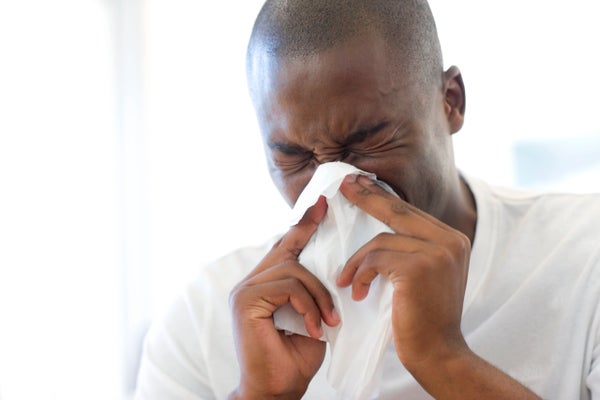Polio, smallpox, hepatitis A and B are all serious viruses humanity learned to subdue with effective solutions. Even the flu, which can shift and mutate each year, has a vaccine. And yet, there’s no remedy for the lowly cold.
That’s not for lack of trying, though. The hunt for a cure for the common cold began in the 1950s, shortly after scientists discovered the primary group of pathogens—known as rhinoviruses—behind the sniffles. Together it accounts for up to 75 percent of colds in adults. But scientists quickly ran into an issue that still stymies researchers today, says Peter Barlow, an immunologist at Edinburgh Napier University in Scotland who is working on a cure for the cold. “The main challenge with rhinovirus is the number of circulating strains,” he says.
There’s at least 160 different strains, or serotypes, of rhinovirus, Barlow says. That means cracking the cold isn’t so much looking for one solution to one problem as it is trying to design a master key to open hundreds of different locks at once. “It’s incredibly difficult to create a vaccine or drug that will target all of those 160 [strains],” Barlow says.
On supporting science journalism
If you're enjoying this article, consider supporting our award-winning journalism by subscribing. By purchasing a subscription you are helping to ensure the future of impactful stories about the discoveries and ideas shaping our world today.
The discovery of these strains, made through the 1990s, was a blow to vaccine development, says virologist Martin Moore of Meissa Vaccines, a company currently developing an inoculation against rhinovirus. “You’ve got this great number of serotypes that circulate all the time, and that really discouraged a lot of people from seriously working on vaccines.” The early work done in the mid-20th century showed simple vaccines could immunize people against one strain, but the idea of developing dozens or even hundreds of vaccines for one illness—let alone a single individual requiring so many shots—is impractical and costly.
Still, researchers are working on some clever work-arounds, Moore says. One way, which a group at Imperial College London is currently investigating, is to discover some part of the viral structure that’s shared between all 160 serotypes. If they can successfully target an immune response against that common structure, then they could design a single vaccine that would offer protection against every strain of rhinovirus.
Moore’s company is going for a more traditional approach, he says. Vaccines can be made to inoculate against one strain, but strains can also be mixed together into a kind of vaccine cocktail. The polio vaccine consisted of all three of polio’s viral serotypes, and the vaccine created against pneumonia has components from 23 different bacterial strains. “People have steadily increased the number of components in vaccines over the years,” Moore says. “It’s just adding more things. We’re taking, I would say, the least exciting approach but, yeah, a tried and true method.”
Moore’s goal is to create a vaccine mix of at least 80 strains, covering the group of rhinovirus serotypes that are the most common and virulent. Unlike the flu virus, Moore says rhinovirus isn’t likely to mutate into new forms—serums created decades ago are still effective against their specific rhinovirus strains today. Once the vaccine is complete, it shouldn’t need much updating. Recently Moore was able to create an effective inoculation with 50 serotypes of rhinovirus, but he doesn’t expect the remaining 30 to come easily. Each new serotype added to the mix costs a significant amount of money and adds complexity to the formula, he says.
Other researchers, like Barlow, are looking for compounds to cure the cold after an infection. For this, researchers are looking to the human body’s own defenses for inspiration. “We’re interested in a family of very tiny molecules found in [human] immune systems known as host defense peptides,” Barlow says. Our immune systems release these compounds after an infection, and he thinks they are able to attack the virus or prevent it from replicating. At the moment, these peptides degrade pretty quickly, so he is trying to find a way to stabilize them so they can be taken as a drug.
Still, some of the challenges don’t lie in rhinovirus’s variegated biology, Barlow says. “There are a lot of societal challenges, I think,” he says. “Even if we find a cure for the cold, it probably won’t be made available to healthy people who shrug the cold off in three to four days.” A cure might not even be that useful, because most people are already recovering by the time they’re able to see a doctor. Plus, you would need to test to see if you even had rhinovirus rather than some unrelated virus that causes identical symptoms such as human coronavirus or adenovirus. “I don’t think there’s particularly been an appetite for developing a drug that acts in the early stages of a cold,” he says.
But a cure is still worth finding, Barlow says. The common cold might be a nuisance that causes most people to lay up for a few days, but it can seriously exacerbate chronic respiratory conditions such as Chronic Obstructive Pulmonary Disease (COPD)or cystic fibrosis. “If someone is in the hospital already and has an exacerbation of an existing disease [from rhinovirus], the medication can be delivered quickly,” he notes. In this case, such a cure could save lives.
